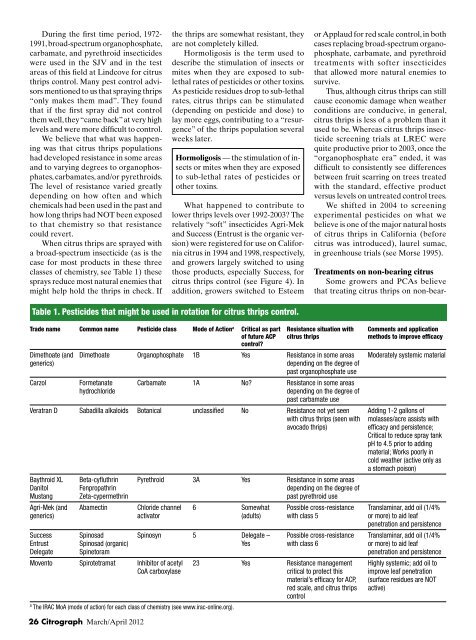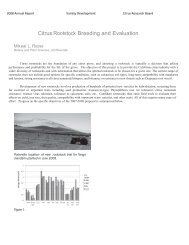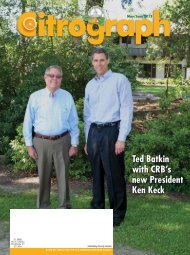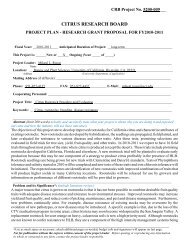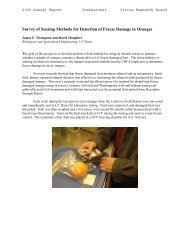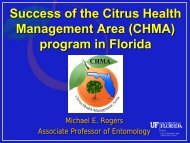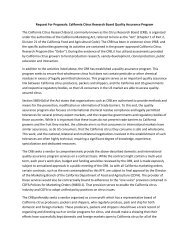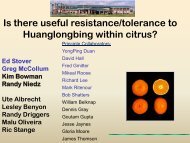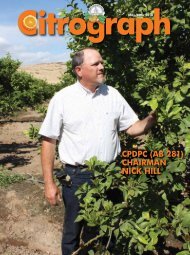IPM practitioner Joe Barcinas with IPM researcher Joseph Morse
IPM practitioner Joe Barcinas with IPM researcher Joseph Morse
IPM practitioner Joe Barcinas with IPM researcher Joseph Morse
You also want an ePaper? Increase the reach of your titles
YUMPU automatically turns print PDFs into web optimized ePapers that Google loves.
During the first time period, 1972-<br />
1991, broad-spectrum organophosphate,<br />
carbamate, and pyrethroid insecticides<br />
were used in the SJV and in the test<br />
areas of this field at Lindcove for citrus<br />
thrips control. Many pest control advisors<br />
mentioned to us that spraying thrips<br />
“only makes them mad”. They found<br />
that if the first spray did not control<br />
them well, they “came back” at very high<br />
levels and were more difficult to control.<br />
We believe that what was happening<br />
was that citrus thrips populations<br />
had developed resistance in some areas<br />
and to varying degrees to organophosphates,<br />
carbamates, and/or pyrethroids.<br />
The level of resistance varied greatly<br />
depending on how often and which<br />
chemicals had been used in the past and<br />
how long thrips had NOT been exposed<br />
to that chemistry so that resistance<br />
could revert.<br />
When citrus thrips are sprayed <strong>with</strong><br />
a broad-spectrum insecticide (as is the<br />
case for most products in these three<br />
classes of chemistry, see Table 1) these<br />
sprays reduce most natural enemies that<br />
might help hold the thrips in check. If<br />
the thrips are somewhat resistant, they<br />
are not completely killed.<br />
Hormoligosis is the term used to<br />
describe the stimulation of insects or<br />
mites when they are exposed to sublethal<br />
rates of pesticides or other toxins.<br />
As pesticide residues drop to sub-lethal<br />
rates, citrus thrips can be stimulated<br />
(depending on pesticide and dose) to<br />
lay more eggs, contributing to a “resurgence”<br />
of the thrips population several<br />
weeks later.<br />
Hormoligosis — the stimulation of insects<br />
or mites when they are exposed<br />
to sub-lethal rates of pesticides or<br />
other toxins.<br />
What happened to contribute to<br />
lower thrips levels over 1992-2003 The<br />
relatively “soft” insecticides Agri-Mek<br />
and Success (Entrust is the organic version)<br />
were registered for use on California<br />
citrus in 1994 and 1998, respectively,<br />
and growers largely switched to using<br />
those products, especially Success, for<br />
citrus thrips control (see Figure 4). In<br />
addition, growers switched to Esteem<br />
or Applaud for red scale control, in both<br />
cases replacing broad-spectrum organophosphate,<br />
carbamate, and pyrethroid<br />
treatments <strong>with</strong> softer insecticides<br />
that allowed more natural enemies to<br />
survive.<br />
Thus, although citrus thrips can still<br />
cause economic damage when weather<br />
conditions are conducive, in general,<br />
citrus thrips is less of a problem than it<br />
used to be. Whereas citrus thrips insecticide<br />
screening trials at LREC were<br />
quite productive prior to 2003, once the<br />
“organophosphate era” ended, it was<br />
difficult to consistently see differences<br />
between fruit scarring on trees treated<br />
<strong>with</strong> the standard, effective product<br />
versus levels on untreated control trees.<br />
We shifted in 2004 to screening<br />
experimental pesticides on what we<br />
believe is one of the major natural hosts<br />
of citrus thrips in California (before<br />
citrus was introduced), laurel sumac,<br />
in greenhouse trials (see <strong>Morse</strong> 1995).<br />
Treatments on non-bearing citrus<br />
Some growers and PCAs believe<br />
that treating citrus thrips on non-bear-<br />
Table 1. Pesticides that might be used in rotation for citrus thrips control.<br />
Trade name Common name Pesticide class Mode of Action a Critical as part Resistance situation <strong>with</strong> Comments and application<br />
of future ACP citrus thrips methods to improve efficacy<br />
control<br />
Dimethoate (and Dimethoate Organophosphate 1B Yes Resistance in some areas Moderately systemic material<br />
generics)<br />
depending on the degree of<br />
past organophosphate use<br />
Carzol Formetanate Carbamate 1A No Resistance in some areas<br />
hydrochloride<br />
depending on the degree of<br />
past carbamate use<br />
Veratran D Sabadilla alkaloids Botanical unclassified No Resistance not yet seen Adding 1-2 gallons of<br />
<strong>with</strong> citrus thrips (seen <strong>with</strong> molasses/acre assists <strong>with</strong><br />
avocado thrips)<br />
efficacy and persistence;<br />
Critical to reduce spray tank<br />
pH to 4.5 prior to adding<br />
material; Works poorly in<br />
cold weather (active only as<br />
a stomach poison)<br />
Baythroid XL Beta-cyfluthrin Pyrethroid 3A Yes Resistance in some areas<br />
Danitol Fenpropathrin depending on the degree of<br />
Mustang Zeta-cypermethrin past pyrethroid use<br />
Agri-Mek (and Abamectin Chloride channel 6 Somewhat Possible cross-resistance Translaminar, add oil (1/4%<br />
generics) activator (adults) <strong>with</strong> class 5 or more) to aid leaf<br />
penetration and persistence<br />
Success Spinosad Spinosyn 5 Delegate – Possible cross-resistance Translaminar, add oil (1/4%<br />
Entrust Spinosad (organic) Yes <strong>with</strong> class 6 or more) to aid leaf<br />
Delegate Spinetoram penetration and persistence<br />
Movento Spirotetramat Inhibitor of acetyl 23 Yes Resistance management Highly systemic; add oil to<br />
CoA carboxylase critical to protect this improve leaf penetration<br />
material’s efficacy for ACP, (surface residues are NOT<br />
red scale, and citrus thrips active)<br />
control<br />
a<br />
The IRAC MoA (mode of action) for each class of chemistry (see www.irac-online.org).<br />
26 Citrograph March/April 2012


